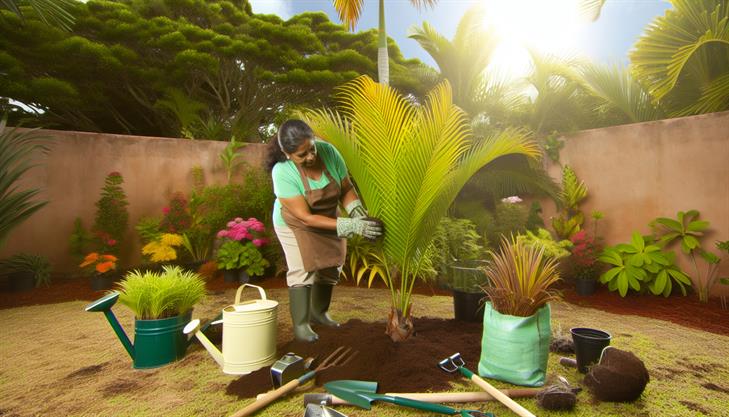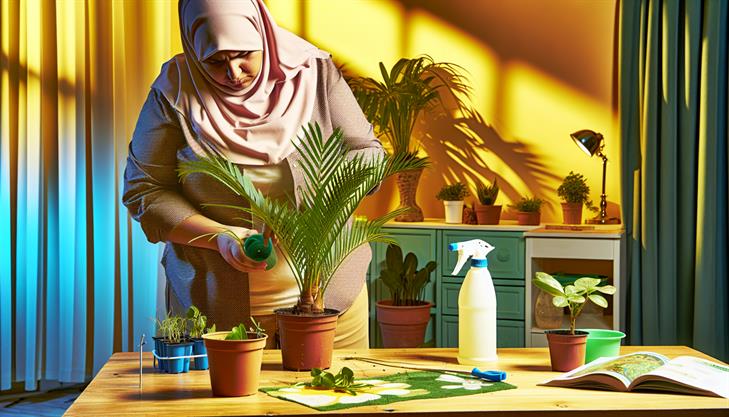Picture this: You’re strolling through a lush garden center when your eyes spot the elegant fronds of an Areca Palm, swaying gently in the breeze. Instantly, you’re captivated by its tropical allure and envision transforming your living room into a serene oasis. But as a budding plant enthusiast, a crucial question lingers in your mind: "Are Areca Palms an annual plant?" Understanding the life cycle of this stunning greenery is more than just a matter of botanical curiosity—it’s a step towards nurturing a vibrant indoor garden.
In today’s blog post, we’re diving deep into the world of Areca Palms, unraveling myths and uncovering truths about their growth patterns. Whether you’re a seasoned horticulturist or someone with a budding interest in plants, knowing whether an Areca Palm is an annual can profoundly influence your plant care routine, budgeting, and long-term planning for indoor greenery. Read on to explore the nuances of Areca Palm care and discover how this plant can become a lasting part of your home decor, ensuring that your investment in beauty and tranquility thrives for years to come.
Understanding the Lifecycle of Areca Palms
Areca palms, scientifically known as Dypsis lutescens, are not annual plants. Instead, they are perennial tropical plants that thrive for several years when properly cared for. Understanding their lifecycle can aid in maintaining their health and vibrancy, making them a popular choice for both indoor and outdoor decor. Here’s what you need to know about the lifecycle of these elegant palms and how to care for them through the years.
Lifecycle of Areca Palms
-
Growth Stage
Areca palms begin growing from seeds in their natural habitat or indoor settings. These seedlings gradually develop into lush, full palms over several years. When placed indoors, they can take a bit longer to mature compared to their natural outdoor growth pace. -
Maturation
Once the plant matures, usually around 4-5 years when conditions are optimal, it can reach a height of up to 6-8 feet indoors, and significantly taller outdoors. During maturity, the palm showcases its signature feathery fronds and gentle arching leaves which add a tropical feel to any space. -
Maintenance and Care
To ensure your areca palm remains healthy throughout its lifecycle, focus on the following care tips:- Light: Provide bright, indirect light. Avoid direct sunlight as it can scorch the leaves.
- Watering: Keep the soil consistently moist but not waterlogged. Water more frequently during the growing season (spring and summer), and reduce during winter.
- Humidity: Areca palms thrive in humid conditions. Consider misting the leaves or using a humidifier to maintain adequate moisture levels, especially in dry indoor environments.
- Fertilization: Use a balanced, liquid fertilizer every few months during the growing season to support vigorous growth. Avoid fertilization in the dormant winter months.
Common Issues
- Yellowing Leaves: Often due to over-watering or poor drainage. Ensure your pot has adequate drainage and adjust watering frequency as needed.
- Brown Leaf Tips: Typically a sign of low humidity or even fluoride in tap water. Use distilled water for irrigation, and increase humidity by misting or placing a tray of water near the plant.
Additional Advice
If you’re growing areca palms for the first time, starting from a small plant rather than seeds can be easier and generally more rewarding. This approach allows you to enjoy the decorative aspect sooner and better manage the care requirements.
By understanding the lifecycle and needs of areca palms, you can enjoy their beauty and elegance for many years. Remember, they are not annual plants but enduring companions in your botanical collection, provided they receive the care suited to their tropical origins.
Planting and Caring for Areca Palms Year-Round
Are Areca Palms Annual or Perennial Plants?
Areca palms, also known as Dypsis lutescens, are not annual plants. They are perennial plants, meaning they live for more than two years and can thrive year-round with proper care. These elegant palms are popular for their lush, feathery fronds and ability to adapt to indoor and outdoor environments, making them a top choice for plant enthusiasts.
Planting Areca Palms
-
Choosing the Right Spot: Whether indoors or outdoors, areca palms prefer bright, indirect sunlight. For indoor planting, place your areca palm near an east or west-facing window. Outdoors, ensure they are not exposed to harsh, direct sunlight, which can scorch the fronds.
-
Selecting the Soil: Use a well-draining, peat-based potting mix to ensure the palm does not retain excess moisture, which can lead to root rot. Slightly acidic to neutral soil pH (6.0 to 7.0) is ideal.
-
Potting and Spacing: If planting in a pot, make sure it has drainage holes to prevent waterlogging. Re-pot every 2-3 years to refresh the soil and provide more room for growth. When planting multiple palms, space them 2-3 feet apart to allow for their mature size.
Caring for Areca Palms Year-Round
-
Watering Needs: Areca palms require regular watering, but be careful not to overwater. Allow the top inch of soil to dry out between waterings. In winter, reduce watering frequency as the plant’s growth slows.
-
Temperature and Humidity: These palms thrive in temperatures between 65°F to 75°F. Avoid exposure to cold drafts and maintain humidity by misting the leaves or setting a humidifier nearby, especially in dry winter months.
-
Fertilizing: Fertilize with a balanced, water-soluble fertilizer every two months during the growing season (spring and summer). Avoid fertilizing in winter to mimic the plant’s natural dormancy period.
-
Pruning: Trim away browning leaves and fronds to maintain appearance and encourage new growth. Use clean, sharp scissors to prevent damage and disease spread.
Common Issues and Solutions
-
Brown Leaf Tips: Often caused by low humidity, excessive sunlight, or over-fertilizing. Increase humidity, adjust the light exposure, and check your fertilizing schedule.
-
Yellowing Leaves: This can be a sign of overwatering. Ensure proper drainage and adjust watering frequency as needed. Yellow leaves can also indicate nutrient deficiency, so consider fertilizing if water and light conditions are stable.
Additional Advice
-
Pest Management: Be vigilant for pests like spider mites and mealybugs. Wipe the leaves with a damp cloth regularly and consider using insecticidal soap for severe infestations.
-
Seasonal Adjustments: In winter, keep areca palms away from cold windows and heating vents. You may need to supplement lighting with grow lights if natural light is insufficient.
By understanding that areca palms are perennial and not annual, and following these care instructions, you can enjoy their tropical beauty year-round, whether indoors or out in the garden. These hardy palms make a stunning addition to any space with the right environment and maintenance.
Tips for Ensuring Healthy Growth and Longevity
Areca palms, also known scientifically as Dypsis lutescens, are not an annual plant; they are actually perennial. In gardening, an "annual" plant completes its life cycle—from germination to the production of seeds—within one growing season before dying. Areca palms, on the other hand, are tropical, evergreen plants that can live and grow for several years with proper care.
Ensuring Healthy Growth and Longevity
To ensure your areca palm thrives, it’s important to provide the appropriate conditions. Below are some guidelines to cultivate your areca palm effectively:
1. Ideal Lighting Conditions
Areca palms require bright, indirect light to thrive. Direct sunlight can scorch their leaves, so placing them near a bright window with filtered light is ideal. If you notice the fronds yellowing or browning, it could be a sign of too much direct sunlight or insufficient light.
2. Temperature and Humidity
These palms thrive in warm, humid conditions, mimicking their native tropical environments. Keep your indoor temperature between 65°F and 75°F (18°C-24°C). Additionally, they benefit from humidity levels above 50%. If your home’s air is dry, especially in winter, consider using a humidifier or mist the leaves regularly.
3. Watering Method
When it comes to watering, areca palms prefer consistently moist soil but do not tolerate waterlogging. Water your palm thoroughly, ensuring that excess water drains out the bottom. Allow the top inch of the soil to dry out between waterings. Overwatering leads to root rot, one of the most common issues faced by these palms.
4. Soil Requirements
Use a well-draining potting mix to prevent water retention. A blend designed for palms or indoor plants works well. Repotting every 2-3 years can help by refreshing the soil and providing more space for root growth.
5. Feeding and Fertilization
During the growing season (spring and summer), feed your areca palm every month with a balanced fertilizer diluted to half strength. Fertilization helps support vigorous growth and maintains the plant’s lush appearance.
6. Pruning Practices
Trimming any brown or yellowing fronds keeps your areca palm looking its best and helps prevent pests and disease. Use clean, sharp scissors to cut fronds close to the stem.
7. Pest and Disease Management
Common pests include spider mites and mealybugs. Regularly inspect your plant and, if needed, treat infestations with insecticidal soap or neem oil. Maintaining the right humidity level can also deter these pests.
Additional Tips
- Avoid placing your areca palm near air vents or drafts, as cool, dry air can damage the plant.
- If your plant seems to be struggling, consider adjusting one or more environmental factors before assuming the worst.
By following these guidelines, you can ensure that your areca palm not only survives but thrives, becoming a stunning centerpiece of your indoor plant collection for years to come.
Common Issues and Troubleshooting Areca Palm Care
Areca palms are a popular choice for indoor and outdoor decoration due to their lush, feathery fronds and tropical appeal. However, many people wonder, "Are areca palms an annual plant?" It’s crucial to clarify that areca palms (Dypsis lutescens), also known as butterfly palms or golden cane palms, are not annuals. They are perennial plants, meaning they live for more than two years and can thrive for many years with proper care.
Understanding Areca Palm Growth:
-
Perennial Nature: Unlike annuals, which complete their life cycle within a year, areca palms continuously grow and develop over time. This long-term growth makes them an excellent choice for those looking to maintain a vibrant, lush aesthetic both indoors and outdoors.
-
Light Requirements: To ensure an areca palm thrives, provide it with bright, indirect sunlight. While they can tolerate lower light conditions, optimal growth occurs when placed near a window with filtered sunlight.
-
Temperature and Humidity Needs: As a tropical plant, areca palms prefer temperatures between 65°F to 75°F (18°C to 24°C). They also thrive in high humidity, so consider using a humidifier or placing a tray of water nearby to maintain moisture in the air.
Common Areca Palm Care Issues and Solutions:
-
Yellowing Leaves: This is a common issue and often indicates overwatering or a nutrient deficiency. Ensure your palm is planted in well-draining soil and water it only when the top inch of the soil feels dry. Use a balanced fertilizer during the growing season to promote healthy foliage.
-
Brown Tips: Brown leaf tips can result from low humidity or excessive fluoride in water. Increase humidity levels around the palm and use distilled or rainwater to avoid fluoride buildup.
-
Pests: Keep an eye out for spider mites and mealybugs, which are common pests. Wipe the fronds with a damp cloth regularly and use insecticidal soap if necessary.
Optimal Setup Tips for Healthy Growth:
-
Potting and Soil: Use a pot with good drainage holes to prevent waterlogging. A mixture designed for palms or a cactus potting mix with added peat moss can work well.
-
Repotting: Areca palms prefer being slightly root-bound, so repot them every 2-3 years or when growth slows significantly. Choose a container only a size or two bigger than the current one to avoid overpotting.
-
Pruning: Regularly remove yellow or brown fronds at the base to encourage new growth and maintain aesthetic appeal. Always use clean, sharp scissors to prevent disease spread.
Additional Advice:
-
Seasonal Changes: During winter, indoor areca palms may require less watering due to slower growth rates. Always adjust care routines to reflect the plant’s seasonal needs.
-
Indoor vs. Outdoor Care: Outdoor palms require more direct sunlight exposure and should be protected from frost. If growing indoors, ensure they have access to sufficient light and remain free from drafts.
By understanding these care practices and addressing common issues, you can enjoy the tropical beauty of your perennial areca palm for many years to come.
Best Tools and Products for Maintaining Areca Palms
Areca palms, also known scientifically as Dypsis lutescens, are not annual plants. Unlike annuals, which complete their life cycle within a single growing season, areca palms are perennial plants, meaning they live for several years. This tropical species is cherished for its lush, feathery fronds and is commonly used as an indoor houseplant or an outdoor ornamental plant in gardens.
Understanding Areca Palms as Perennials
Life Cycle and Growth: As perennials, areca palms grow continuously year over year, reaching up to 10 feet indoors and even taller when grown outdoors in suitable climates. Their long-lifespan and graceful appearance make them a popular choice for adding greenery to homes and offices.
Climate Suitability: Originating from Madagascar, areca palms thrive in warm, humid conditions. They are best suited to USDA hardiness zones 10 to 11. In cooler climates, they must be kept indoors or in a greenhouse during colder months to avoid frost damage.
Setup Tips for Areca Palms
Choosing the Right Location:
- Indoors: Place your areca palm in a bright area with indirect sunlight. Direct sunlight can scorch the leaves, while too little light may stunt growth. A spot near an east or west-facing window is ideal.
- Outdoors: If planting outside, choose a location with partial shade to protect the palm from intense afternoon sun.
Soil and Potting:
- Use well-draining potting soil; a peat-based mix with added perlite or sand works well to prevent waterlogging.
- A pot with drainage holes is essential to prevent root rot.
Care Tips for Long-Term Maintenance
Watering:
- Areca palms prefer consistently moist soil but should never sit in water, as this can lead to root rot. Water thoroughly when the top inch of soil feels dry.
- To maintain humidity, especially indoors, mist the leaves regularly or employ a humidity tray.
Fertilization:
- Feed your areca palm with a balanced liquid fertilizer every two to three months during the growing season (spring and summer). Reduce feeding in the winter when growth slows down.
Common Issues and Solutions
- Yellowing Leaves: Often a sign of overwatering or poor drainage. Ensure the pot has proper drainage, and adjust your watering schedule.
- Brown Leaf Tips: This can occur due to dry air or lack of water. Increase humidity levels and ensure the plant is adequately watered.
- Pest Problems: Areca palms can occasionally attract pests like spider mites and mealybugs. Regularly inspect the leaves and use insecticidal soap or neem oil if needed.
Additional Advice
To keep your areca palm looking its best, periodically remove any dead or damaged fronds. This encourages new growth and helps maintain the plant’s health. With proper care, your areca palm will not only enhance your living space but thrive for many years as a beautiful, enduring addition to your plant collection.
By understanding that areca palms are not annual plants, you can implement the appropriate care and cultivation techniques, ensuring a long life and vibrant foliage for your indoor or outdoor plant setting.
In conclusion, while areca palms are often mistaken for annual plants due to their popularity in various garden settings, they are actually tropical perennials. We have explored their native habitat, growth requirements, and ideal conditions, helping you understand how to best care for them as long-term houseplants or outdoor specimens in suitable climates. These palms thrive in warm temperatures, indirect sunlight, and well-draining soil, making them a low-maintenance yet rewarding addition to your plant collection.
Now that you’re equipped with knowledge about areca palms, consider incorporating them into your home or garden to not only enhance aesthetic appeal with their lush, feathery fronds but also to enjoy their natural air-purifying benefits.
As a final tip, remember that consistent care and attention to proper watering are crucial for the health of your areca palm. Be mindful of the signs of overwatering, such as yellowing leaves, and adjust your watering schedule accordingly to keep your palm thriving for many years to come.


